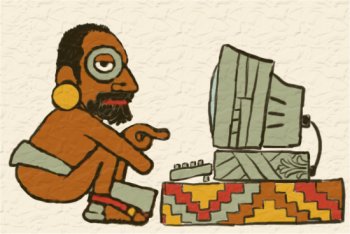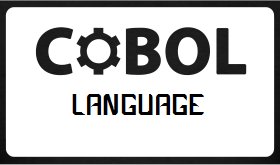COBOL: in search of fresh blood
 They say a well-written program on COBOL reads like a novel. Even a non-programmer can fully understand what is happening in the program in this language, which greatly simplifies maintenance if the code is written correctly. In a world where there is no time to find time to document programs, COBOL is largely self-documenting. Simple at first glance, COBOL, which began its story by listing with line numbering, allows you to create very powerful code with your own tools.
They say a well-written program on COBOL reads like a novel. Even a non-programmer can fully understand what is happening in the program in this language, which greatly simplifies maintenance if the code is written correctly. In a world where there is no time to find time to document programs, COBOL is largely self-documenting. Simple at first glance, COBOL, which began its story by listing with line numbering, allows you to create very powerful code with your own tools.However, will this help the language today?
 Does it make sense today for an IT specialist to start exploring COBOL? It may seem that this makes as much sense as to start exploring Windows XP. But this is far from the case. COBOL is one of the oldest programming languages in the world, it still lives and flourishes in a huge number of programs in banking, financial, industrial and other fields all over the world.
Does it make sense today for an IT specialist to start exploring COBOL? It may seem that this makes as much sense as to start exploring Windows XP. But this is far from the case. COBOL is one of the oldest programming languages in the world, it still lives and flourishes in a huge number of programs in banking, financial, industrial and other fields all over the world.COBOL did not retire, no, but here is a generation of programmers who have written all these applications - they are leaving for a well-deserved rest. That is why there is a lack of knowledge to maintain these programs and keep them up to date.
In a press release on Micro Focus website, Kevin Brerlie, responsible for managing software products at Micro Focus, said:
COBOL currently supports 90% of the business systems used by Fortune 500 corporations and is used in 85% of all daily financial (business) transactions. Hence the conclusion - teaching COBOL at universities will give students knowledge that is useful in life, and they will be able to use them further - in organizations that are directly related to business. Without this, risks to a business using COBOL will increase.
The good news is that Micro Focus has expanded its support program for schools, businesses, and students to help educate a new generation of COBOL developers.
According to Micro Focus, the new support program will stimulate the development of the COBOL language in schools, there will be competitions with subsequent awards with the possibility of internships.
Brerli also added that enterprises today must understand - the world is moving forward, and in order to keep up - it is necessary to bridge the gap in skill levels between generations of developers, to unite them and their knowledge.
Micro Focus provides this software for free, including Enterprise Developer and Visual COBOL products. As well as all the necessary documentation.
Statistics
At the same time, the editor of the well-known journal CRN, Sander Hulsman writes that in 73% of universities, regular COBOL teaching does not develop. Interestingly, this situation does not coincide with the opinion of the directors of higher educational institutions. Of the 119 directors polled around the world, 58% said that Cobol should be taught and developed. Also note that 27% of universities still continue to teach this oldest programming language.
')
 Alas, in educational institutions COBOL is replaced by the languages Java, C # and C ++ (the most popular language is Java).
Alas, in educational institutions COBOL is replaced by the languages Java, C # and C ++ (the most popular language is Java).This is confirmed by Huib Klink, a senior sales consultant at Micro Focus: “New programming languages such as Java and C # are very popular among students. But the COBOL language is firmly entrenched in enterprises and there will be a demand for COBOL programmers for a long time. Our study found that seven out of ten universities, at least in the next ten years, will continue to work with applications written in COBOL. And 25% instead of ten is called twenty years. ”
And, repeating, the words of Kevin Brerli, said above: if you do not study COBOL, the risks associated with business will increase.
From posts on Habré also interview with Grace Hopper ("grandmother COBOL") and Dijkstra 's statement about this language can be interesting.
PS A couple of code examples on COBOL
In the list of languages highlighted by Habrom, there is no Cobol, however ...
The shortest program:
$ SET SOURCEFORMAT"FREE" IDENTIFICATION DIVISION. PROGRAM-ID. ShortestProgram. PROCEDURE DIVISION. DisplayPrompt. DISPLAY " ". STOP RUN. Multiply the two numbers entered:
$ SET SOURCEFORMAT"FREE" IDENTIFICATION DIVISION. PROGRAM-ID. Multiplier. DATA DIVISION. WORKING-STORAGE SECTION. 01 Num1 PIC 9 VALUE ZEROS. 01 Num2 PIC 9 VALUE ZEROS. 01 Result PIC 99 VALUE ZEROS. PROCEDURE DIVISION. DISPLAY " : " WITH NO ADVANCING. ACCEPT Num1. DISPLAY " : " WITH NO ADVANCING. ACCEPT Num2. MULTIPLY Num1 BY Num2 GIVING Result. DISPLAY " = ", Result. STOP RUN. Material translated and processed from the sites:
- cfoworld.com.au (05/11/2013, author not listed)
- computable.nl (05/14/2013, by Sander Hulsman, ext. Dirk Munk)
Source: https://habr.com/ru/post/139573/
All Articles